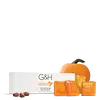What's inside
What's inside
 Key Ingredients
Key Ingredients

No key ingredients
 Benefits
Benefits

 Concerns
Concerns

 Ingredients Side-by-side
Ingredients Side-by-side

Triethanolamine
BufferingTea-Stearate
CleansingSodium Tallowate
CleansingGlycerin
HumectantTea-Lauryl Sulfate
CleansingSodium Cocoate
CleansingWater
Skin ConditioningSodium Ricinoleate
CleansingSodium Oleate
CleansingCetyl Acetate
EmollientCocamide Mea
EmulsifyingParfum
MaskingSodium Stearate
CleansingAcetylated Lanolin Alcohol
EmollientBHT
AntioxidantTocopheryl Acetate
AntioxidantTetrasodium Etidronate
Emulsion StabilisingTrisodium Hedta
Sodium Metabisulfite
AntioxidantTriethanolamine, Tea-Stearate, Sodium Tallowate, Glycerin, Tea-Lauryl Sulfate, Sodium Cocoate, Water, Sodium Ricinoleate, Sodium Oleate, Cetyl Acetate, Cocamide Mea, Parfum, Sodium Stearate, Acetylated Lanolin Alcohol, BHT, Tocopheryl Acetate, Tetrasodium Etidronate, Trisodium Hedta, Sodium Metabisulfite
Sodium Palmate
CleansingAlcohol Denat.
AntimicrobialWater
Skin ConditioningSodium Cocoate
CleansingSucrose
HumectantGlycerin
HumectantSodium Stearate
CleansingParfum
MaskingCitrus Aurantium Dulcis Oil
MaskingTetrasodium Etidronate
Emulsion StabilisingPentasodium Pentetate
CI 19140
Cosmetic ColorantButyrospermum Parkii Butter
Skin ConditioningCucurbita Pepo Seed Oil
EmollientCI 17200
Cosmetic ColorantIngredients Explained
These ingredients are found in both products.
Ingredients higher up in an ingredient list are typically present in a larger amount.
Glycerin is already naturally found in your skin. It helps moisturize and protect your skin.
A study from 2016 found glycerin to be more effective as a humectant than AHAs and hyaluronic acid.
As a humectant, it helps the skin stay hydrated by pulling moisture to your skin. The low molecular weight of glycerin allows it to pull moisture into the deeper layers of your skin.
Hydrated skin improves your skin barrier; Your skin barrier helps protect against irritants and bacteria.
Glycerin has also been found to have antimicrobial and antiviral properties. Due to these properties, glycerin is often used in wound and burn treatments.
In cosmetics, glycerin is usually derived from plants such as soybean or palm. However, it can also be sourced from animals, such as tallow or animal fat.
This ingredient is organic, colorless, odorless, and non-toxic.
Glycerin is the name for this ingredient in American English. British English uses Glycerol/Glycerine.
Learn more about GlycerinParfum is a catch-all term for an ingredient or more that is used to give a scent to products.
Also called "fragrance", this ingredient can be a blend of hundreds of chemicals or plant oils. This means every product with "fragrance" or "parfum" in the ingredients list is a different mixture.
For instance, Habanolide is a proprietary trade name for a specific aroma chemical. When used as a fragrance ingredient in cosmetics, most aroma chemicals fall under the broad labeling category of “FRAGRANCE” or “PARFUM” according to EU and US regulations.
The term 'parfum' or 'fragrance' is not regulated in many countries. In many cases, it is up to the brand to define this term.
For instance, many brands choose to label themselves as "fragrance-free" because they are not using synthetic fragrances. However, their products may still contain ingredients such as essential oils that are considered a fragrance by INCI standards.
One example is Calendula flower extract. Calendula is an essential oil that still imparts a scent or 'fragrance'.
Depending on the blend, the ingredients in the mixture can cause allergies and sensitivities on the skin. Some ingredients that are known EU allergens include linalool and citronellol.
Parfum can also be used to mask or cover an unpleasant scent.
The bottom line is: not all fragrances/parfum/ingredients are created equally. If you are worried about fragrances, we recommend taking a closer look at an ingredient. And of course, we always recommend speaking with a professional.
Learn more about ParfumSodium Cocoate can be bad for dry skin.
Sodium stearate is the sodium salt of stearic acid.
The structure of sodium stearate makes it both a cleanser and emulsifier. As a cleanser, it helps dissolve dirt, oil, and other pollutants. As an emulsifier, it helps prevent ingredients from separating. This adds stability to the formula.
We don't have a description for Tetrasodium Etidronate yet.
Water. It's the most common cosmetic ingredient of all. You'll usually see it at the top of ingredient lists, meaning that it makes up the largest part of the product.
So why is it so popular? Water most often acts as a solvent - this means that it helps dissolve other ingredients into the formulation.
You'll also recognize water as that liquid we all need to stay alive. If you see this, drink a glass of water. Stay hydrated!
Learn more about Water